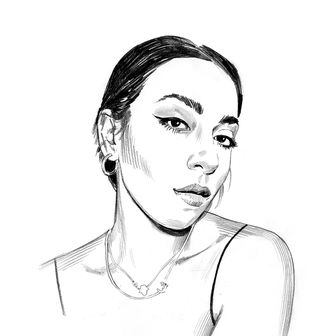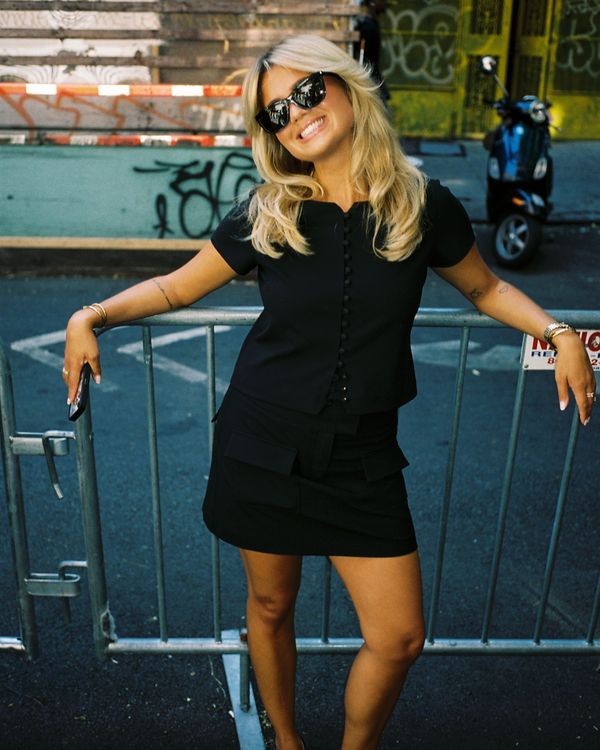
Matilda Djerf’s hair — her famous, internet-shattering, vigorously emulated hair — is quite literally glistening like velvet in the morning sun, sitting on her head like an anointed crown. It’s nearly September and the intense weight of New York’s summer is just beginning to give way to the mildness of fall, but Djerf, a Swedish native, is worried about the humidity in the air. She says she can practically feel her hair frizzing up, but it only takes a quick glance to prove that not a single strand is out of place from her honey-toned Brigitte Bardot bouffant.
Djerf, an influencer and entrepreneur, has had a blowout (no pun intended) year. Her personal style and sensibility unintentionally helped define and begrudgingly propagate multiple trends online, like the “clean girl,” “vanilla girl,” or “stealth wealth” aesthetics (something Djerf told me she does not like at all. “I hate trends,” she says. “I don’t want to be the face of that. That’s not something I support”). Djerf’s hair, as we now know it, became an entity of its own and a photocopied phenomenon with the search “Matilda Djerf hair” having 13.8 million views on TikTok alone. Her spotlight continued to grow with her social followings flourishing at a combined 4 million followers across platforms, a Vogue Scandinavia cover under her belt, and nearly every U.S-based fashion outlet turning their gaze in her direction. Most notable, though, is the success of her clothing venture, Djerf Avenue, one focused on Scandinavian sensibilities and minimalism — blazers, trousers, inconspicuous dresses, and daintily-printed loungewear are markers of the line. Her life and business partner, Rasmus, tells me the brand made a revenue of $35 million this past year.
Djerf grew up in Borås, Sweden, a city known for textiles with a population of just over 100,000 people. She was the youngest of three children (“I’ve always been the baby,” she says) to two parents who she describes as “really supportive.” After graduating high school, eager to leave her hometown, Djerf decided to travel the world. She began uploading photos of herself in places like the Caribbean, Australia, and Bali to Instagram, quickly amassing a significant following of 100,000 — a sizable chunk, especially by 2015 standards.
“When I was younger, I knew that I wanted to do something that helped other people,” Djerf tells me. When I ask Djerf how she feels she helps people in her current role, she says, “I’m not saying that I am, but if I am helping one person every day, that’s a really special thing for me. I really want to encourage people to go their own way. And also, I hope that I’m helping people take care of themselves better, because I feel like it’s such a fast-paced world, but the pockets of stillness in my life are crucial for my well-being. I hope I inspire people to get in nature a little bit, take a little morning to yourself.”
Djerf’s desire to inspire, in whatever shape or form, has taken root among her young and wide-reaching audience. Her cultlike following mimic much of what she does and turn to her to be a guiding light through their adolescence and young adulthood by way of her occasional “Ask Me Anything” Instagram Story sessions. The comment sections across her social-media presence gush with admiration. It’s worth noting, though, that for a brief instant in October that feels nearly forgotten now, her own fan base turned on her. Fans who had purchased dupes, or near-identical copies, of Djerf Avenue prints and clothing, were being served copyright infringement notices across TikTok, forcing them to remove the content they’d posted in their knock-offs. Her disciples felt momentarily burned: “She acts like she owns the style even though it’s been a thing in Scandinavia,” one comment on TikTok read.
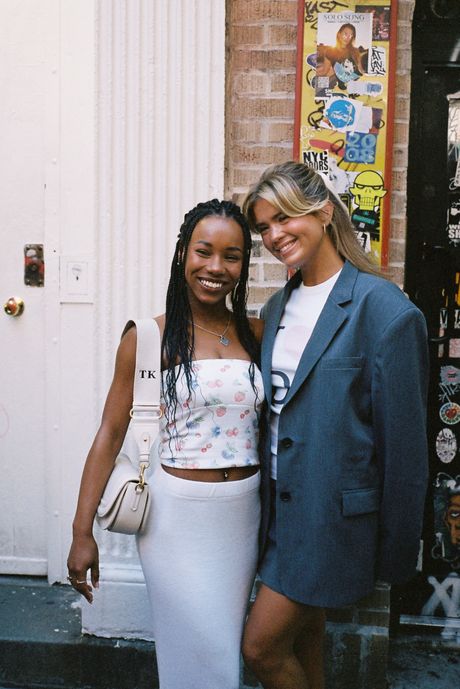
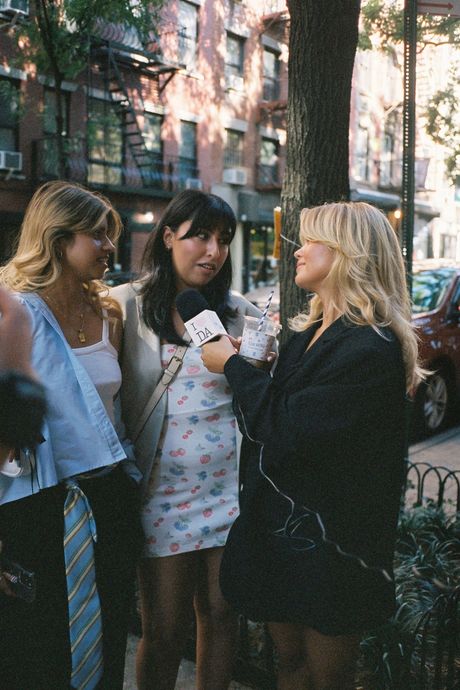
At the time, Djerf deactivated her account on the app, and in a statement to the Cut, her team told us the brand had been recently “affected by a surge in websites selling products with our exact prints.” Their explanation went on to say that they used an external IP firm to monitor copyright infringements of their owned prints, and the firm sent the cease and desists. “As soon as we realized that our safeguarding routines had inadvertently impacted individual accounts, we instructed our IP firm not to report such videos.”
Since then, Djerf has reactivated her TikTok and, as with nearly all immaterial internet drama, the fervor quickly subsided and anyone trolling her, at least in the public sphere, has momentarily returned to their caverns.
Earlier this year, I meet Djerf at the Crosby Hotel in Soho. She’s in New York City to open a much-anticipated pop-up for her brand. Before we start our interview, she needs to alert the front desk of an incessantly loud banging that rang in her room throughout the night. She’s wearing a black, form-fitting dress and a gray Djerf Avenue blazer draped over her shoulders, paired with black Chanel block kitten heels. Visibly charmed, three men working behind the desk at the hotel lean in when she speaks; her voice is polite, and the man behind the computer beams at her. He assures her he’ll take care of it, and she thanks him. It’s a glimpse into the quiet magnetism she possesses.
Several mornings later at barely 9 a.m., the Djerf Avenue pop-up line, filled with girls wearing bows, blazers, and kitten heels, as Djerf often does, stretches down the block and around the corner. Hundreds of young women, or “Djerf Avenue Angels,” as she calls them, are waiting for a chance to become one degree of separation closer to perhaps becoming Djerf herself by purchasing something from her brand. But more so, they’re there to catch even just a glimpse of the influencer and, hopefully, get to meet her.
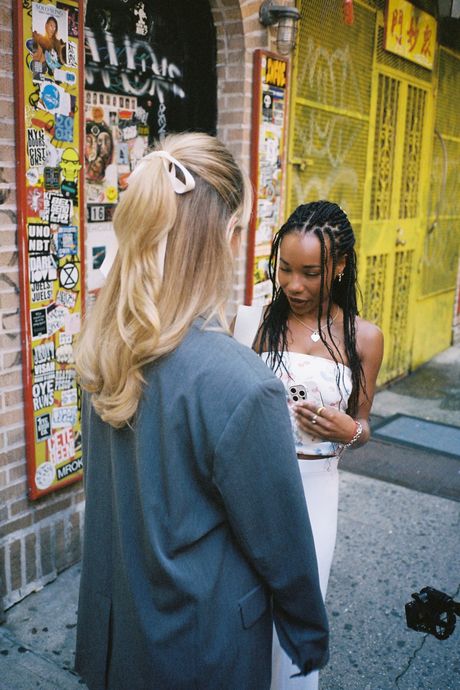
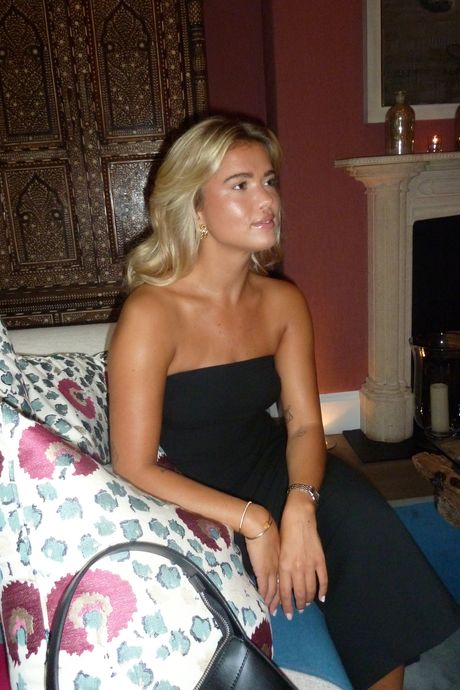
Three women, aged 21, 20, and 19, head the front of the line. They have been waiting since 5 a.m., all skipping class, to see Djerf and her “amazing hair,” as one says. Over the several hours they’d waited, the group made friends with two security guards in charge of the door. “People say don’t meet your idols, but it’s so different with her.” They rave to me about her style, how consistent and “timeless” it is across her social-media presence, and joke they’ve been “indoctrinated” to consider wearing ballet flats again thanks to her. “She’s just ‘It!’” they agree.
After Djerf ceremoniously opens the doors to the shop, frenetic fans begin streaming in, some playing it cool and looking at the garments hanging about and others making a beeline to chat with the star of the moment. One girl, nervously stroking her hair and seemingly near tears, needs some coaxing from her mother to approach Djerf, who smiles and offers a hug. Djerf moves around the room with the demeanor of a royal but with the geniality any member of the British monarchy could only wish for. Evidently, the most captivating and consistent trait Djerf has embodied all throughout her sashay into the spotlight is her ability to perform love and compassion, both online and in person, to her millions of fans.
“My vision is to make Djerf Avenue a really safe space for our community, whether you’re a buying customer, or you’re just an engaged follower on Instagram, or you just pop in there every now and then for a little peek,” Djerf says. “I want people to come onto our socials or website and just feel like, ‘Okay, I feel good being here.’”
A few evenings later, Djerf hosts a fashion show of sorts (she refuses, at the moment, to attend any fashion week: “Until I feel good being in a space like that,” she says, “I’m not going to attend”) at the Guggenheim for hundreds of her “angels.” Her show is filled with women of different body types, races, and ethnicities. During a speech Djerf makes, a colleague relays to me, from under her long, blonde hair and tanned skin, Djerf uses “language of diversity” and inclusivity. Her attendees cheer enthusiastically.
To her fans, it seems Djerf symbolizes a lifestyle, one in which ease can not only co-exist with strife (she’s made her ectopic pregnancy and subsequent emergency medical termination known and is open about her past battles with anxiety and disordered eating, ignoring the hundreds of requests to post what she eats in a day and her workouts: “I want to be really responsible with how I speak about certain things. I’ve struggled with an eating disorder. If you want to see that you’ll have to go somewhere else”), but even overtake it. The imagery on her Instagram makes life look slow and rich with experience: long days spent at her Swedish cottage, dripping wet hair draped over a terry cloth robe; a wooly, knit scarf wrapped around her coiffed tresses; a dog, well-groomed and sleepy, lounging on a beige couch. It leaves the viewer with a feeling of both knowing — that they’ve maybe once experienced the seeming contentment Djerf exudes online — and longing.
I ask Djerf how this voyeurism has changed her life over the course of her explosive rise to fandom in the past few years. “I feel more watched than I did before. I feel like people always want something from me,” she says. “Five years ago, I didn’t feel that way. I feel like someone always wants something.”
“Does that make it hard for you to trust people?” I ask.
Before I finish the question, she responds emphatically: “Yes.”


